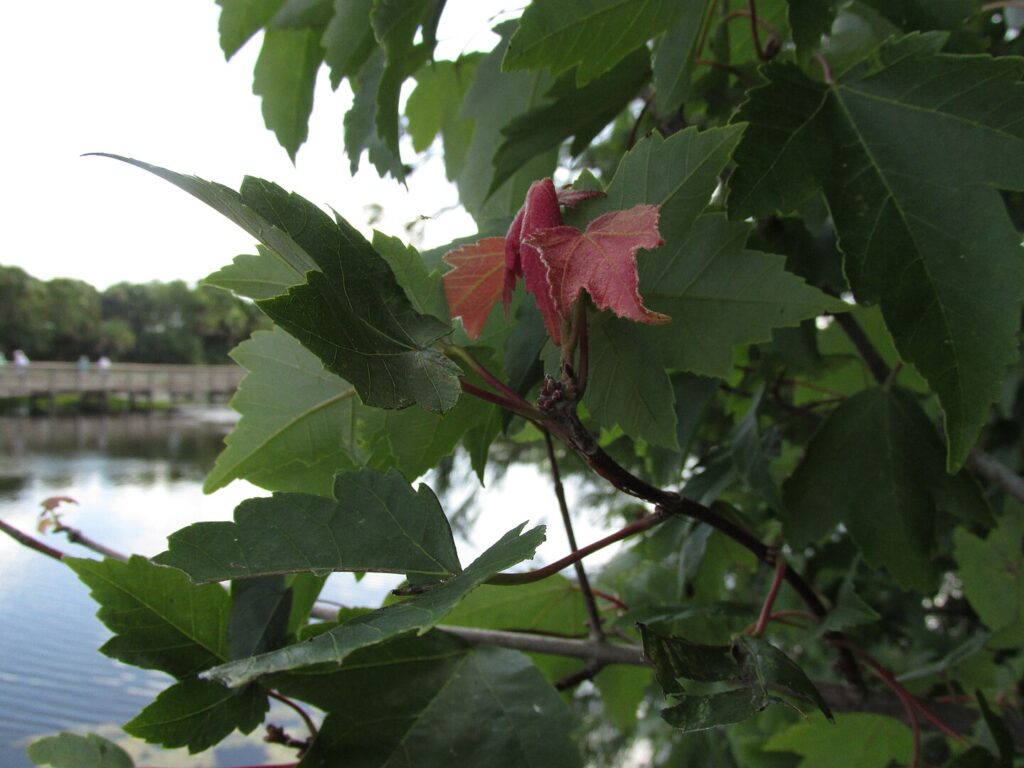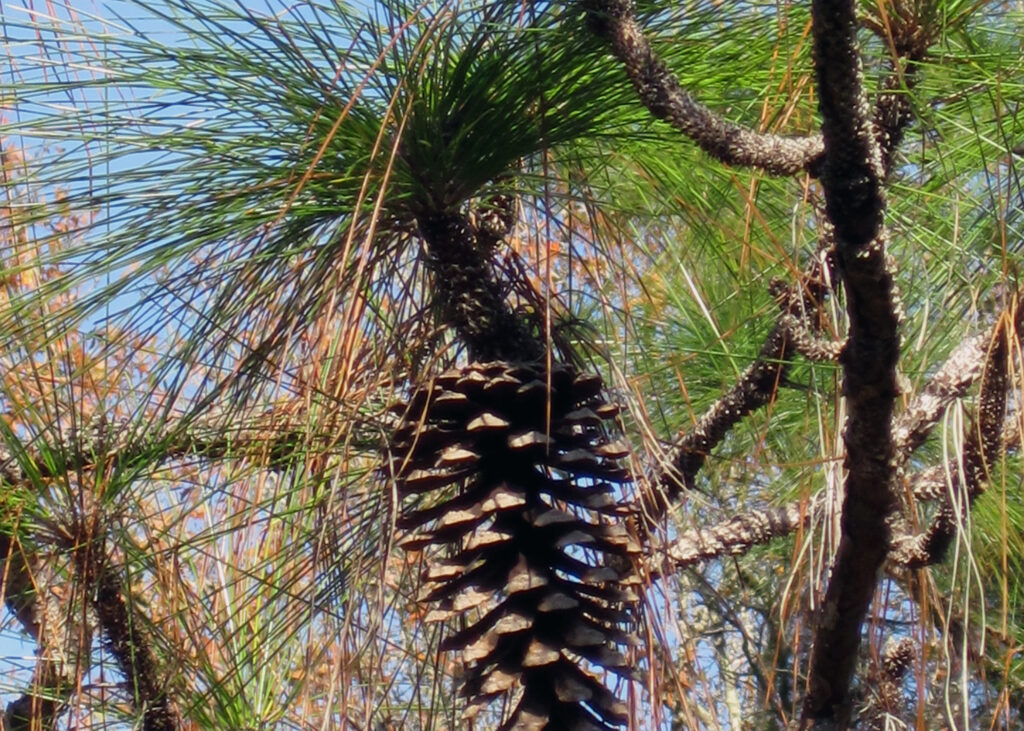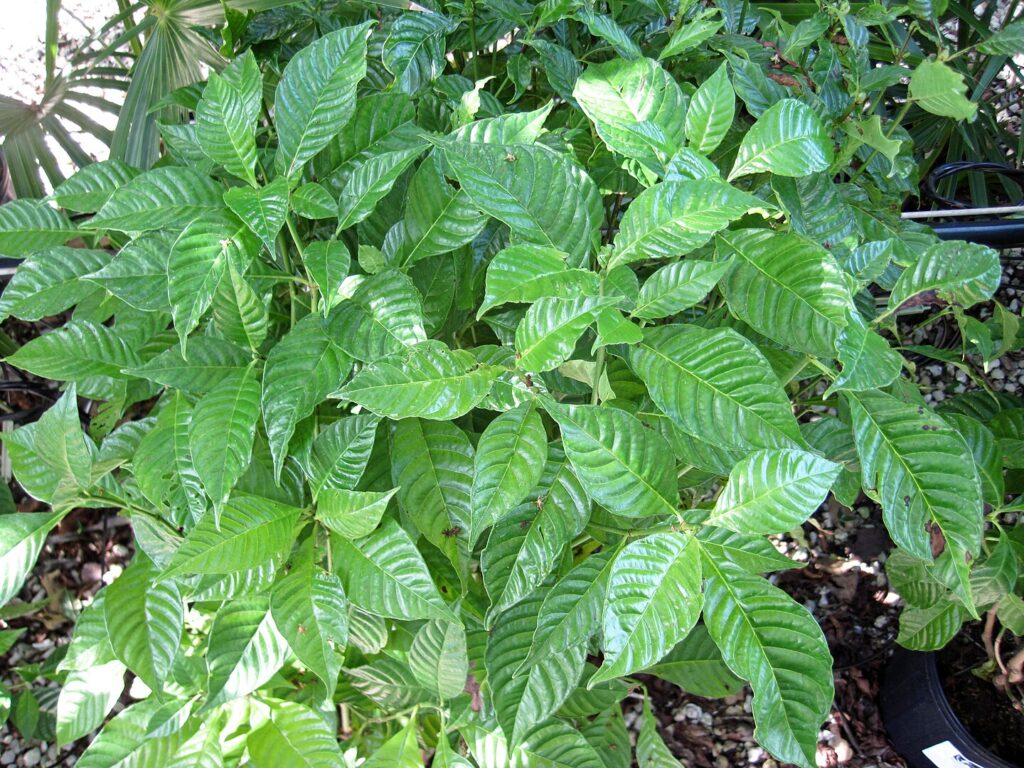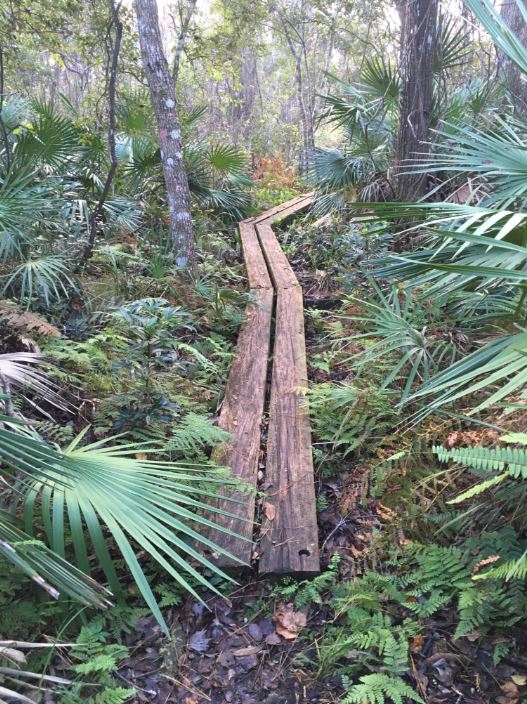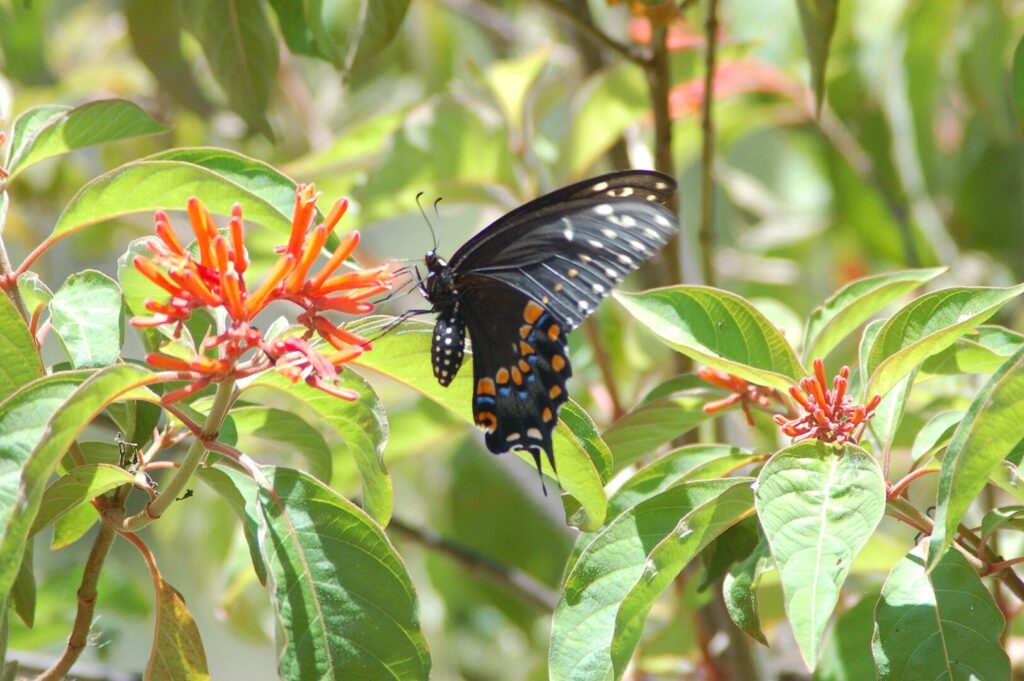Trees are quite literally the backbone of any wildlife-friendly Florida garden. They provide the structural framework that supports entire communities of birds, butterflies, mammals, and countless other creatures that make Florida gardens come alive. Unlike shrubs or groundcovers, trees for Florida wildlife create the vertical layers that transform a simple yard into a thriving ecosystem. They offer everything from nesting sites sixty feet above ground to root systems that support soil-dwelling insects and fungi below.
Let’s explore two distinct categories of native Florida trees that every wildlife gardener should understand. First, we’ll help you identify the magnificent large native trees that may already grace your neighborhood or nearby natural areas. These towering giants — live oaks, bald cypresses, longleaf pines, and others — serve as wildlife powerhouses, supporting hundreds of species each.
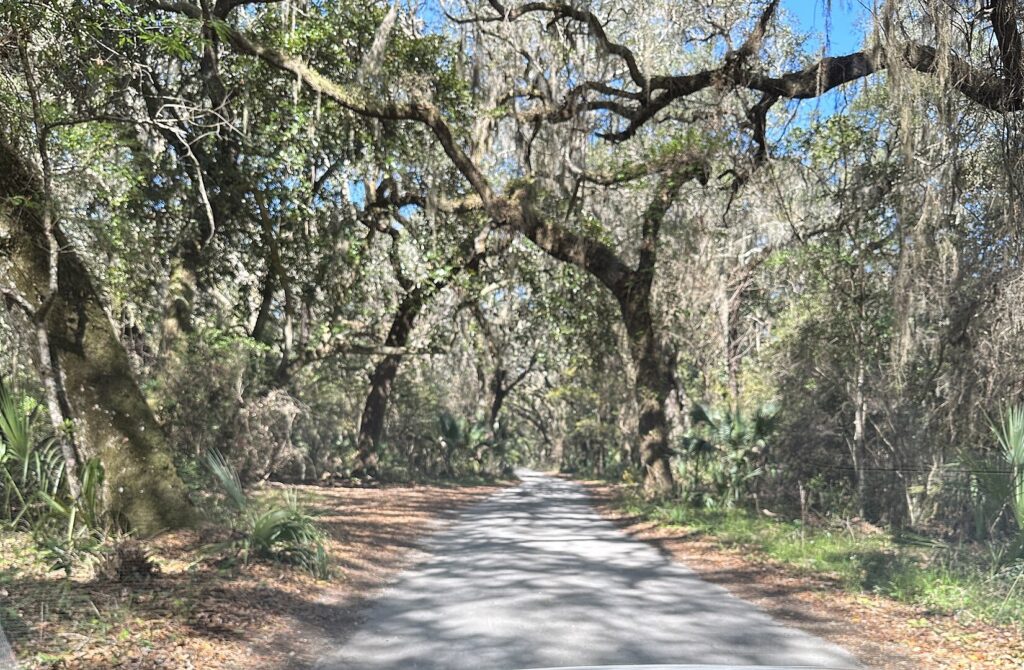
While most homeowners won’t be planting 80-foot trees in their backyards, learning to recognize and appreciate these ecological anchors will deepen your understanding of how your smaller tree choices fit into the larger landscape.
Then we’ll shift focus to the practical: small to medium-sized native trees that you can realistically add to your property. These are the trees that will transform your garden from a green space into a wildlife sanctuary. From the hummingbird-attracting coral bean to the butterfly-supporting wild coffee, each species we’ll discuss brings its own unique cast of wildlife visitors.
We’ll also cover the art and science of using these trees in your landscape design, creating the layered habitats that wildlife seeks while maintaining the beauty and functionality you want from your outdoor space. Finally, we’ll walk through the practical aspects of when and how to plant these native gems, setting them up for success in Florida’s unique climate.
Whether you’re just beginning your journey into wildlife-friendly gardening or you’re ready to add the crucial tree layer to an existing native plant garden, this guide will give you the knowledge and confidence to choose and plant trees that will benefit Florida’s wildlife for generations to come.
Large Native Trees: Know Your Neighborhood Giants
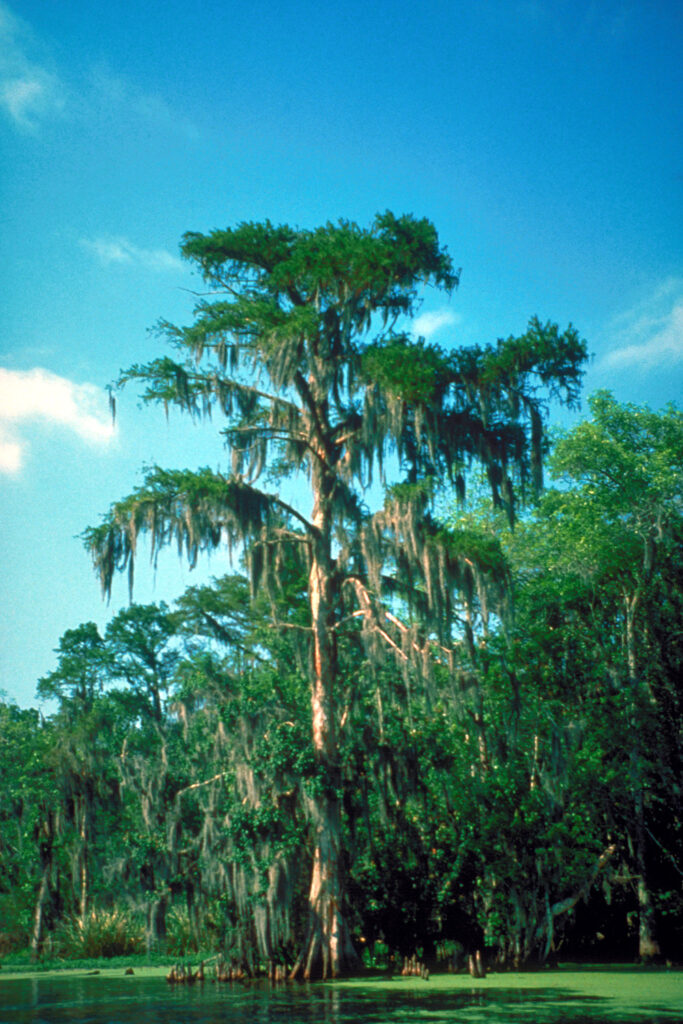
Understanding Florida’s magnificent large native trees is essential for any wildlife gardener, even if you’ll never plant one yourself. These towering giants serve as wildlife hotels, supporting hundreds of species and creating the ecological framework that your smaller plantings will complement.
Learning to identify these trees will help you understand your local ecosystem and make informed decisions about which smaller species will thrive in your specific environment.
Coastal Ecosystem Giants
Live Oak (Quercus virginiana)
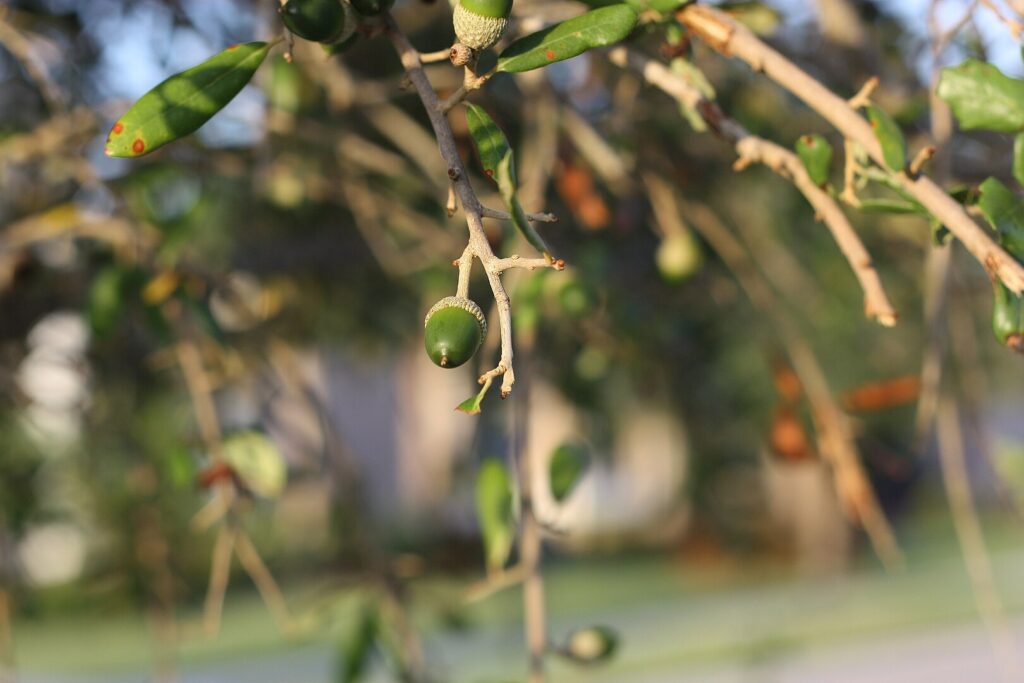
The live oak stands as Florida’s most iconic tree, easily recognized by its massive, spreading canopy and distinctive horizontal branching pattern. Unlike most oaks, live oaks are evergreen, retaining their leathery, oval leaves year-round, though they do drop them gradually in spring as new growth emerges. The bark is dark brown to gray with deep furrows, and mature trees develop the characteristic gnarled, sculptural appearance that makes them so beloved in Southern landscapes.
Live oaks are wildlife powerhouses, supporting over 500 species of moths and butterflies—more than almost any other North American tree. Their prolific acorn production feeds squirrels, deer, wild turkeys, and numerous other mammals and birds. The expansive canopy provides nesting sites for everything from tiny warblers to large raptors, while the trunk’s crevices shelter bats, owls, and countless insects. Woodpeckers particularly favor live oaks, creating cavities that later serve as homes for flying squirrels, screech owls, and wood ducks.
Cabbage Palm (Sabal palmetto)
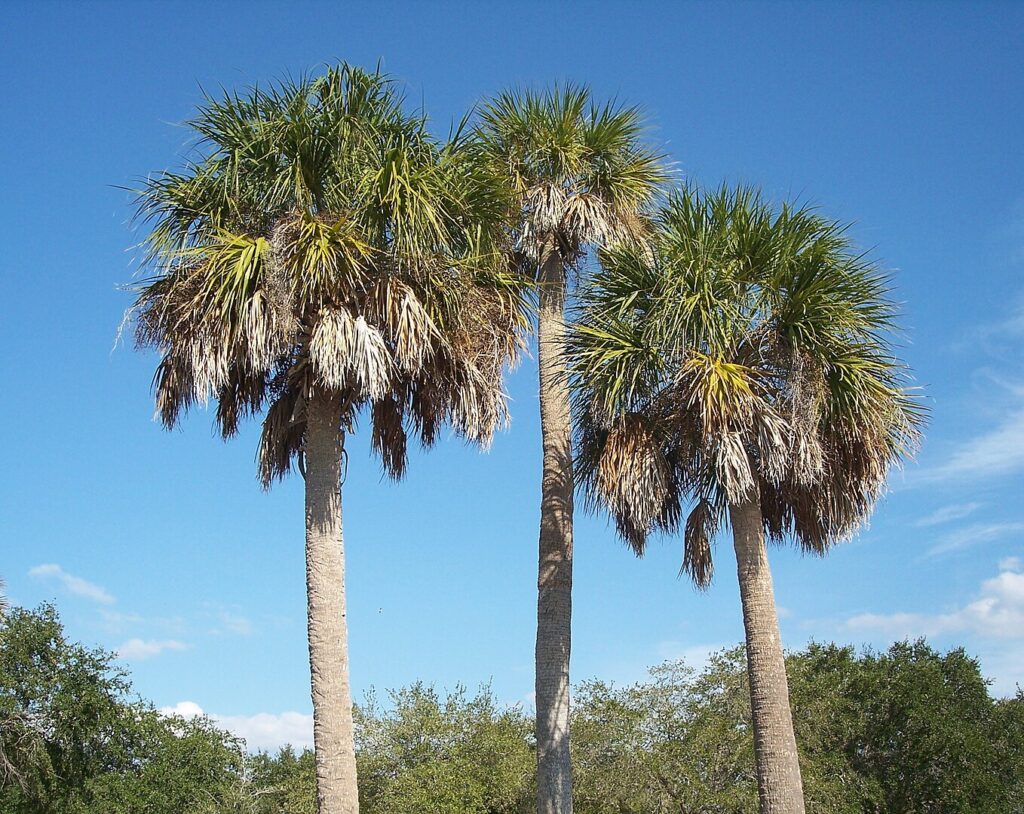
Florida’s state tree is unmistakable with its single, unbranched trunk topped by a crown of large, fan-shaped leaves. The trunk often retains old leaf bases, creating a distinctive “petticoat” effect, though some specimens shed these cleanly. Mature cabbage palms produce large clusters of small white flowers followed by dark berries about the size of peas.
The berries are a crucial food source for migratory birds, particularly during fall migration when flocks of robins, cedar waxwings, and other species depend on this reliable food source. Native bees and other pollinators visit the flowers, while the leaf crown provides nesting sites for mockingbirds and other songbirds. Small mammals, including raccoons and opossums, also feed on the fallen fruit.
Wetland Giants
Bald Cypress (Taxodium distichum)
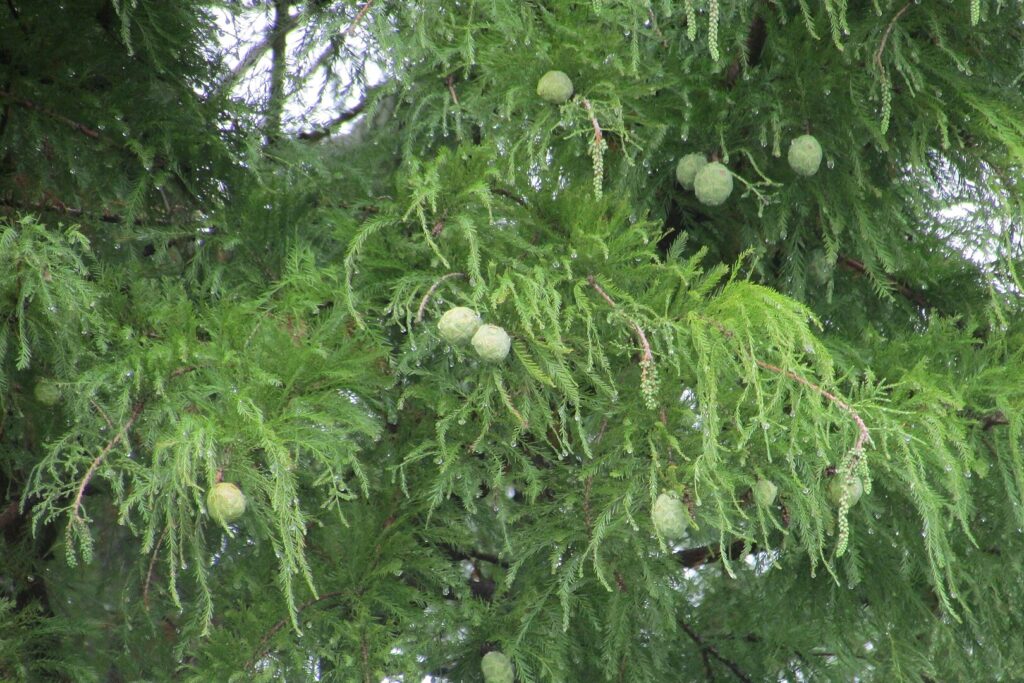
The bald cypress is one of Florida’s most distinctive trees, easily identified by its buttressed base and the mysterious “knees” that protrude from the water around its roots. This deciduous conifer turns brilliant orange-brown in fall before dropping its soft, needle-like leaves. The fibrous, reddish-brown bark peels in strips, and mature trees develop the classic swollen base that helps stabilize them in wet conditions.
Bald cypress swamps provide critical habitat for wood ducks, which nest in tree cavities, and great blue herons, which build large stick nests in the canopy. The trees support specialized wildlife like cypress moths and various aquatic insects. During winter, the bare branches provide perfect perching and roosting sites for migratory waterfowl, while the underwater root systems create nursery areas for fish and amphibians.
Red Maple (Acer rubrum)
Red maples are easily identified by their palmate leaves with three to five lobes and their brilliant red fall color. In early spring, clusters of small red flowers appear before the leaves, followed by distinctive red, winged seeds called samaras. The bark is smooth and gray on young trees, becoming darker and furrowed with age.
This native maple supports over 285 species of moths and butterflies, making it one of the most valuable trees for insectivorous birds. The early spring flowers provide crucial nectar for native bees and other pollinators when few other sources are available. Seeds feed numerous bird species, while the trunk often hosts maple boring beetles and other specialized insects that, in turn, feed woodpeckers and other insect-eating birds.
Pine and Sandhill Giants
Longleaf Pine (Pinus palustris)
The longleaf pine is distinguished by its extremely long needles—up to 18 inches—that grow in clusters of three. Young trees go through a distinctive “grass stage” where they resemble a fountain of long green needles with no visible trunk. Mature trees develop a tall, straight trunk with minimal lower branching and distinctive plated bark. The large cones can reach up to 10 inches long.
Longleaf pines are keystone species in their ecosystem, supporting the endangered red-cockaded woodpecker, which excavates nest cavities in living trees. Pine warblers, brown-headed nuthatches, and other specialized birds depend on longleaf pine forests. The open understory created by natural fire cycles provides habitat for gopher tortoises, whose burrows shelter over 350 other species. The seeds feed numerous birds and small mammals, while the resin supports specialized insects.
Southern Magnolia (Magnolia grandiflora)
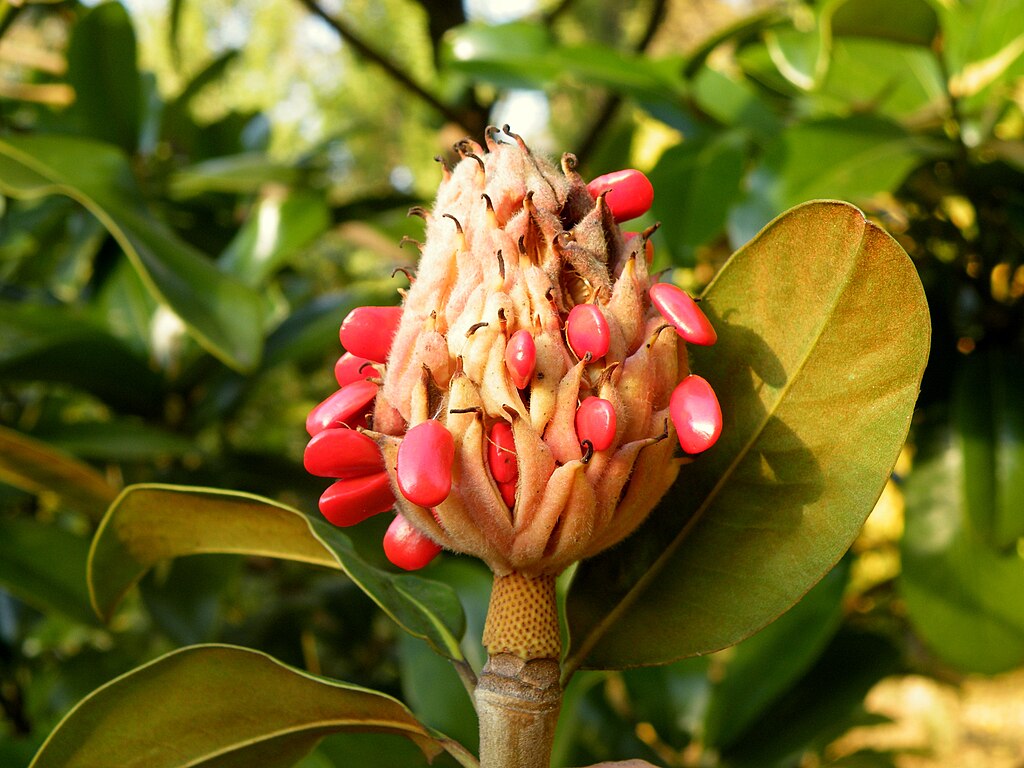
Southern magnolias are unmistakable with their large, glossy, dark green leaves that have rusty-brown undersides. The spectacular white flowers can reach 12 inches across and emit a powerful, sweet fragrance. After flowering, cone-like seed pods split open to reveal bright red seeds that dangle on silky threads.
The large flowers attract beetles, which were among the earliest pollinators and are perfectly adapted to magnolia reproduction. The seeds provide food for squirrels, turkeys, and other wildlife, while migratory birds often feed on the insects attracted to the fragrant flowers. The dense evergreen canopy provides year-round shelter and nesting sites, particularly valuable during winter months.
These magnificent trees create the template for understanding how native trees support wildlife. As you plan your own wildlife-friendly landscape, consider how your smaller tree choices can complement and connect to these neighborhood giants, creating corridors and layered habitats that support the full spectrum of Florida’s remarkable biodiversity.
Small Trees for Homeowner Planting: Your Plantable Palette
Now that you understand the magnificent giants that anchor Florida’s ecosystems, let’s explore the practical side of wildlife gardening: small to medium-sized native trees that you can actually plant in your landscape.
These trees for Florida wildlife represent your opportunity to create meaningful habitat while maintaining a manageable garden scale. Each species brings its own unique community of wildlife visitors, and strategic selection can transform your property into a year-round wildlife sanctuary.
Coastal-Tolerant Small Trees (10-25 feet)
Coastal areas present unique challenges for trees for Florida wildlife, including salt spray, sandy soils, and intense sun exposure. These resilient species have evolved to thrive in these conditions while providing essential resources for both resident and migratory species.
Firebush (Hamelia patens)
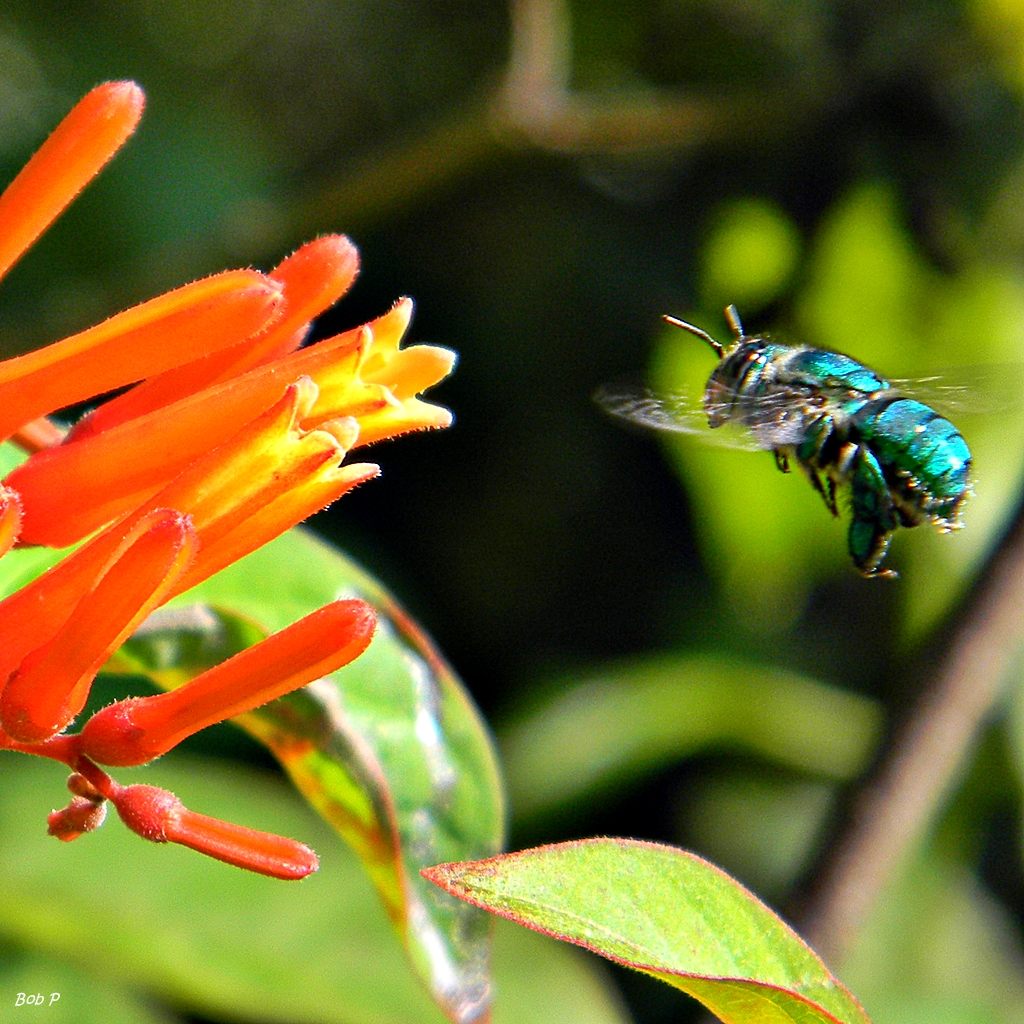
Perhaps no other small tree delivers more wildlife bang for your buck than the firebush, a true champion among trees for Florida wildlife. This fast-growing native reaches 8-12 feet tall and equally wide, creating a rounded, dense shrub that functions as a small tree when properly pruned. The tubular orange-red flowers bloom almost continuously from spring through fall, making it an invaluable nectar source when many other plants have finished blooming.
Firebush flowers are specifically adapted to attract hummingbirds, with their bright red color and tubular shape perfectly matching ruby-throated hummingbird feeding behavior. However, the wildlife benefits extend far beyond hummingbirds. Long-tongued native bees, butterflies, and sphinx moths also visit the flowers regularly.
The small black berries that follow the flowers are beloved by at least 20 species of songbirds, including mockingbirds, cardinals, and various warblers. Migratory species particularly value firebush berries during fall migration, when this reliable food source can mean the difference between successful migration and starvation.
The plant’s salt tolerance makes it excellent for coastal properties, while its drought tolerance, once established, means minimal maintenance. Firebush responds well to pruning and can be trained into a small tree form by removing lower branches and selecting a central leader.
Coral Bean (Erythrina herbacea)
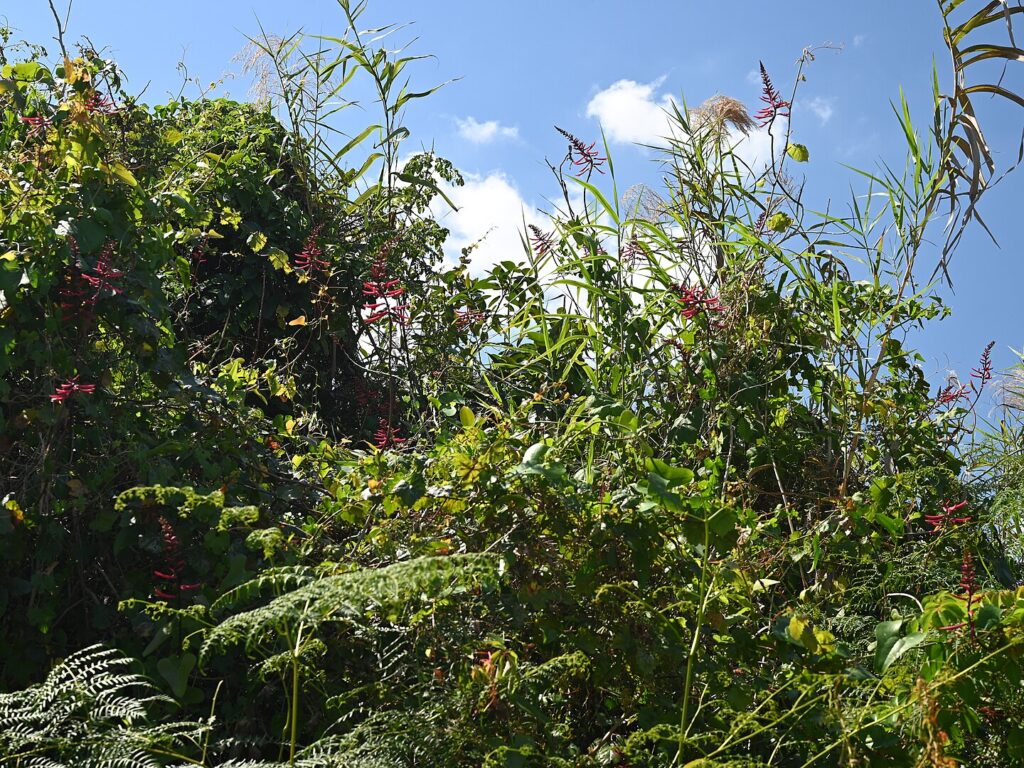
The coral bean tree offers one of the most spectacular floral displays among trees for Florida wildlife. This small native tree typically reaches 10-15 feet tall, with an open, somewhat irregular branching pattern that gives it character in the landscape. The compound leaves consist of three heart-shaped leaflets, but it’s the extraordinary flowers that make this tree unforgettable.
In late spring and early summer, coral bean produces dramatic spikes of bright red, tubular flowers at the branch tips. These flowers are specifically evolved to attract hummingbirds, and during peak bloom, a single tree can support multiple feeding hummingbirds throughout the day. The flowers also attract long-tongued native bees and occasionally sphinx moths during evening hours.
After flowering, the tree produces distinctive pods containing bright red seeds. While these seeds are toxic to mammals, they play an important role in the tree’s reproduction strategy. The tree itself provides perching spots for small birds and nesting opportunities for species that prefer somewhat open branch structures.
Coral bean is remarkably adaptable to coastal conditions, tolerating salt spray and sandy soils while requiring minimal water once established. The tree is deciduous, losing its leaves in winter, but the interesting branch structure provides visual interest even when bare. This characteristic also makes it valuable for wildlife that prefers open perching spots during winter months.
Marlberry (Ardisia escallonioides)
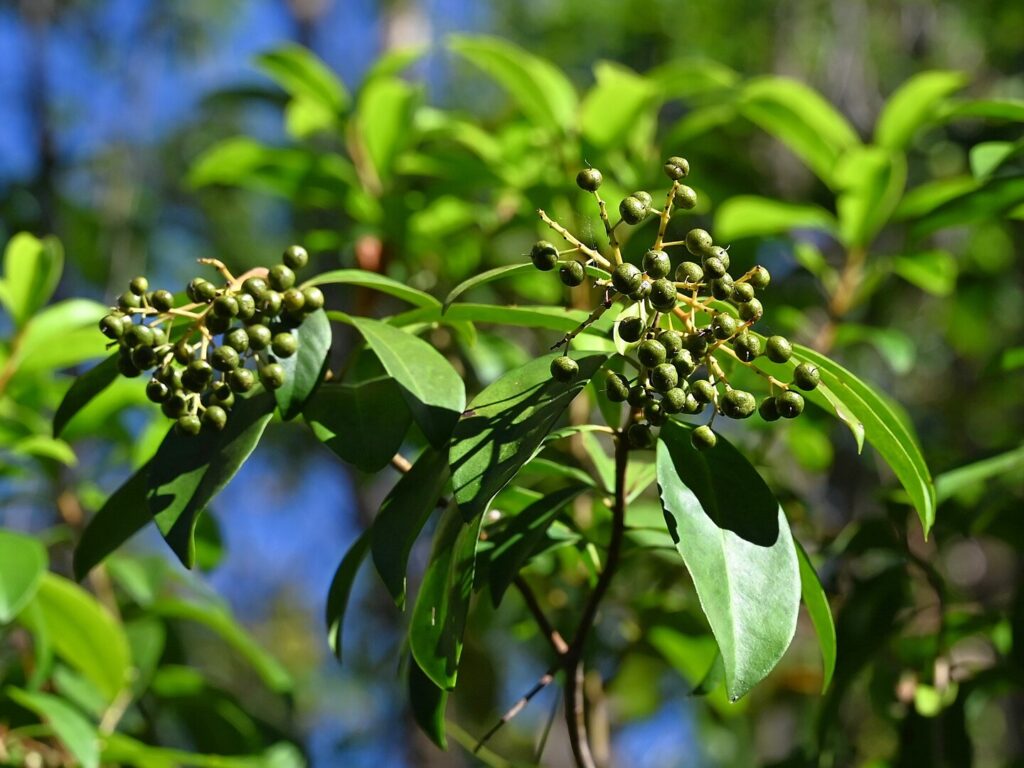
Often overlooked among trees for Florida wildlife, marlberry deserves serious consideration for coastal properties. This small evergreen tree typically reaches 15-25 feet tall with a narrow, upright form that works well in smaller spaces or as part of a mixed planting. The glossy, dark green leaves are attractive year-round, while small white flowers in spring give way to the tree’s real wildlife treasure: abundant small black berries.
Marlberry produces berries prolifically, and these fruits are absolutely critical for migratory birds. During fall migration, flocks of robins, cedar waxwings, thrushes, and other songbirds depend on marlberry’s reliable fruit production. The berries ripen over an extended period, providing food resources from late summer through winter. Over 30 species of birds have been documented feeding on marlberry fruits, making it one of the most valuable fruiting trees for Florida wildlife.
The tree’s evergreen nature provides year-round shelter and nesting opportunities, particularly valuable in coastal areas where salt-tolerant cover can be limited. Small mammals, including raccoons and opossums, also feed on fallen berries, while the flowers attract native bees and other small pollinators.
Marlberry’s exceptional salt tolerance makes it ideal for properties within several miles of the coast. It adapts to various soil types, from sandy coastal soils to heavier inland conditions, and requires minimal care once established. The tree can be pruned to maintain a smaller size or allowed to reach its natural height as a backdrop plant.
These coastal-tolerant trees for Florida wildlife represent just the beginning of your planting palette. Each offers unique benefits while tolerating the challenging conditions found near Florida’s extensive coastline. By incorporating these species into your landscape design, you’ll create habitat that supports both year-round residents and the countless migratory species that depend on coastal Florida’s resources during their epic journeys.
Wetland-Edge Small Trees
Wetland edges represent some of the most biodiverse habitats in Florida, and selecting appropriate trees for Florida wildlife in these areas can dramatically increase your property’s ecological value. These species thrive in moist conditions while tolerating periodic flooding, making them perfect for low-lying areas, pond edges, or anywhere water tends to collect.
Sweet Bay Magnolia (Magnolia virginiana)

Sweet bay magnolia stands out among trees for Florida wildlife with its elegant form and incredible fragrance. Reaching 20-30 feet tall, this semi-evergreen magnolia produces creamy white flowers from late spring through summer. The 4-6 inch blooms emit an intense, sweet fragrance that can perfume an entire garden area.
The flowers specifically attract beetles, which are pollinators perfectly adapted to magnolia reproduction. This ancient pollination relationship supports numerous beetle species that, in turn, feed insectivorous birds. The fragrant blooms also draw swallowtail butterflies and sphinx moths. Following flowering, cone-like seed pods split to reveal bright red seeds that feed squirrels, wood ducks, and various songbirds.
Sweet bay’s silvery leaf undersides create beautiful movement in breezes, while the semi-evergreen nature provides winter shelter. The tree tolerates wet feet better than most magnolias, making it ideal for challenging wetland-edge sites.
Red Chokeberry (Aronia arbutifolia)
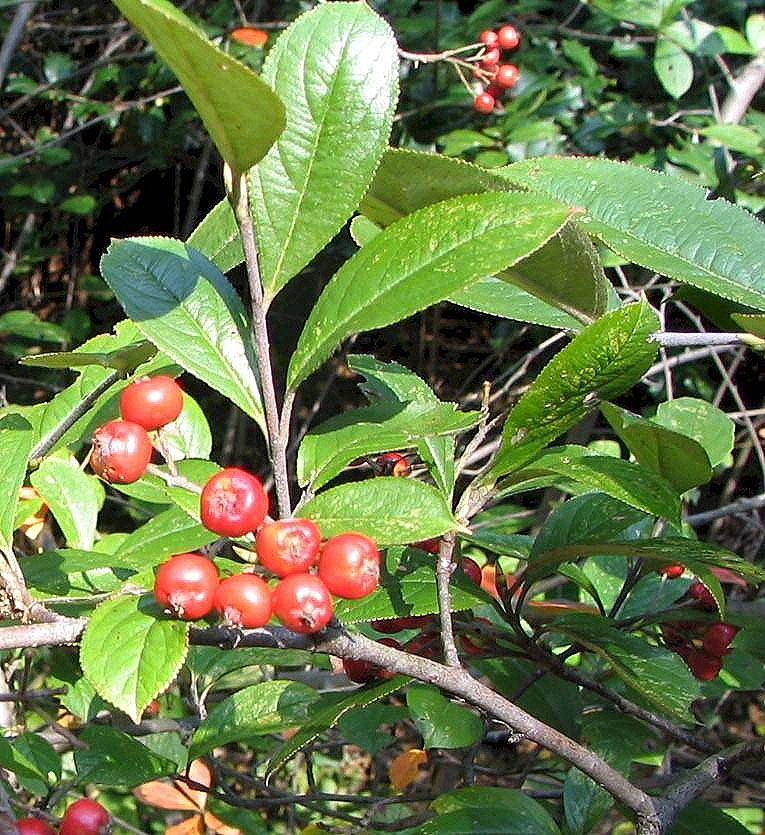
Despite its unfortunate common name, red chokeberry ranks among the most valuable trees for Florida wildlife. This multi-stemmed small tree reaches 8-12 feet tall, producing clusters of white flowers in early spring followed by persistent red berries that last well into winter.
The berries are absolutely crucial for wildlife, supporting over 40 bird species including thrushes, waxwings, woodpeckers, and gamebirds. The fruit’s persistence through winter makes it especially valuable when other food sources become scarce. Early spring flowers provide nectar for native bees when few other sources are available.
Red chokeberry adapts to various moisture levels, from consistently wet to seasonally dry, making it versatile for different wetland-edge conditions. The plant produces excellent fall color, with leaves turning brilliant red-orange before dropping.
Buttonbush (Cephalanthus occidentalis)
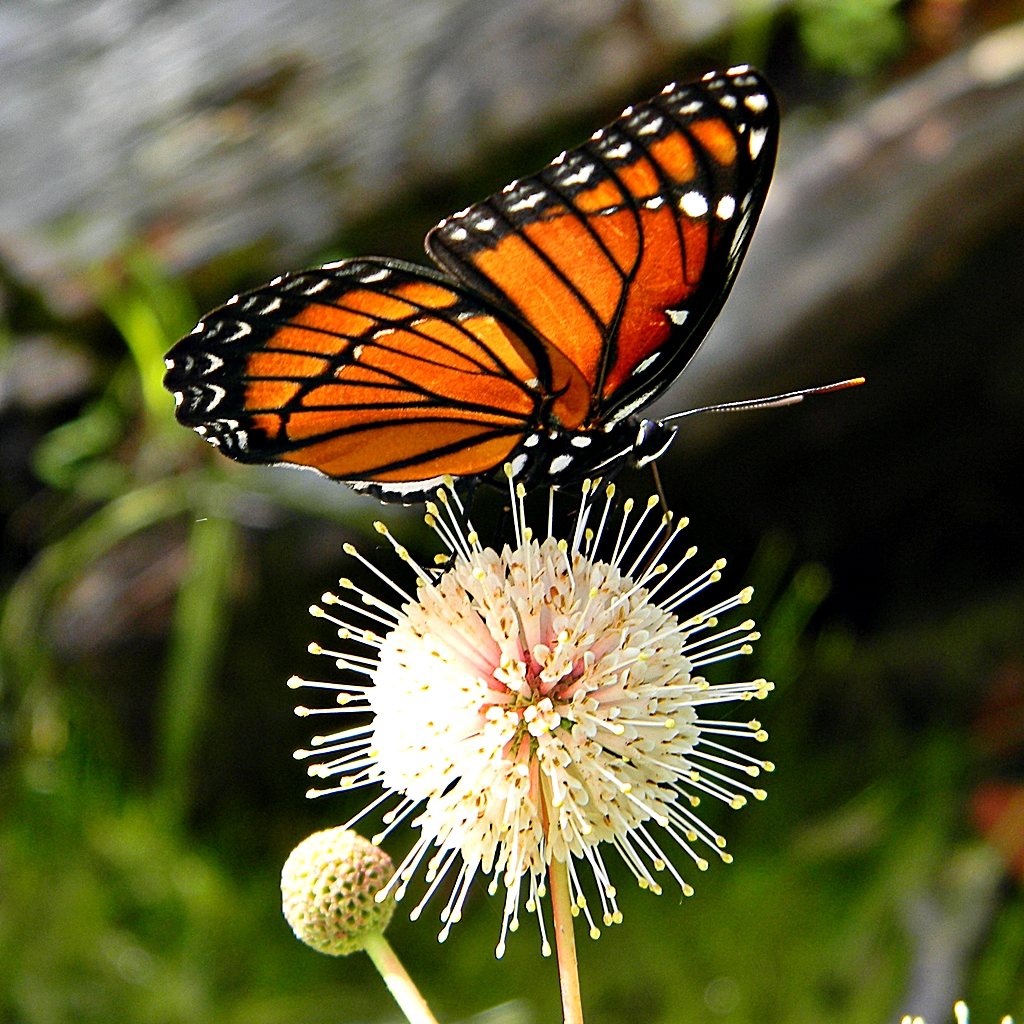
Buttonbush offers unique spherical white flowers that make it instantly recognizable among trees for Florida wildlife. This small tree reaches 8-15 feet tall with an open, somewhat irregular form. The distinctive round flower clusters, about 1-2 inches in diameter, bloom from late spring through summer.
The unusual flowers are magnets for butterflies, native bees, and hummingbirds. Over 20 butterfly species regularly visit buttonbush, including skippers, swallowtails, and fritillaries. The flowers also attract beneficial insects like hover flies and native wasps that help control garden pests.
Waterfowl particularly value buttonbush, with wood ducks and other species using the small seeds as food. The plant’s tolerance for standing water makes it perfect for pond edges or areas with poor drainage. During winter, the persistent seed heads provide food for finches and other seed-eating birds.
Buttonbush can handle everything from full sun to partial shade and thrives in consistently moist to wet conditions. It’s one of the few trees for Florida wildlife that actually prefers having “wet feet,” making it perfect for those challenging boggy areas where other trees struggle.
These wetland-edge trees for Florida wildlife excel in moisture-rich environments while providing essential resources for both aquatic and terrestrial species. Their ability to bridge the gap between water and land habitats makes them particularly valuable for creating diverse wildlife communities on your property.
Pine/Sandhill Small Trees
Pine flatwoods and sandhill ecosystems cover vast areas of Florida, characterized by well-drained sandy soils and full sun conditions. These trees for Florida wildlife have adapted to thrive in these challenging conditions while supporting specialized wildlife communities that depend on open, sunny habitats.
Chickasaw Plum (Prunus angustifolia)
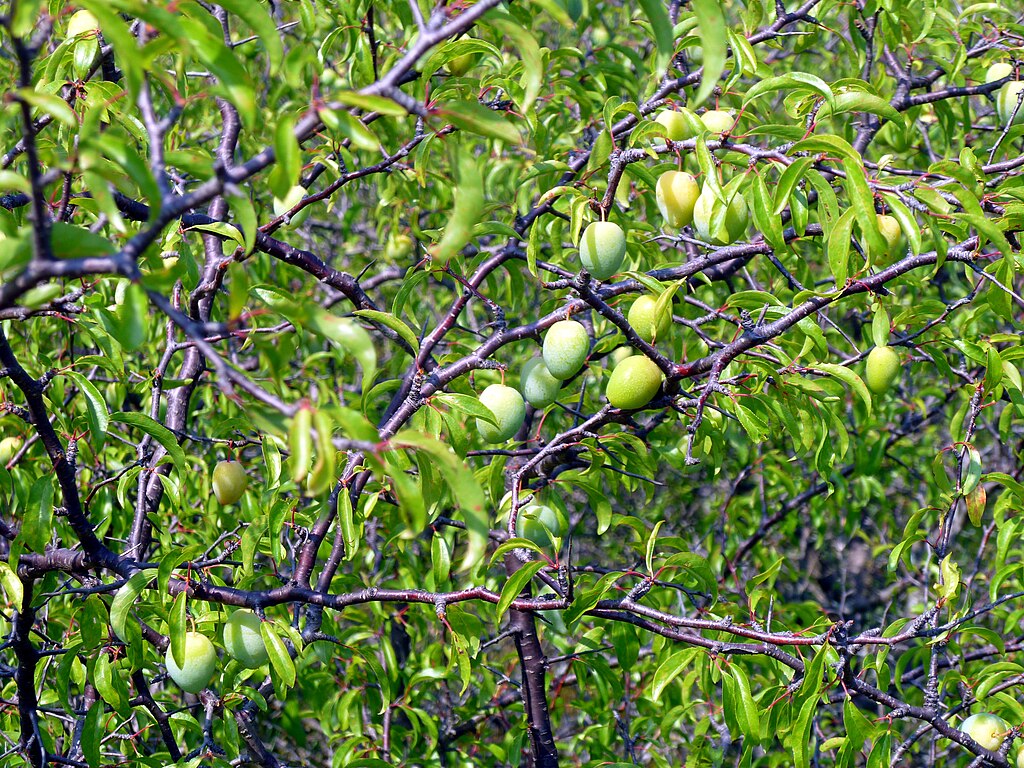
Chickasaw plum delivers exceptional early-season value among trees for Florida wildlife. This small native tree reaches 12-20 feet tall, forming dense thickets through root suckers when left unmanaged, or training into an attractive single-trunk specimen with proper pruning. In late winter to early spring, before leaves emerge, the tree becomes covered in masses of small white flowers.
These early blooms are absolutely critical for native bees emerging from winter dormancy when few other nectar sources exist. Over 40 native bee species depend on Chickasaw plum flowers, including mason bees, leafcutter bees, and various solitary species. The timing makes this tree indispensable for supporting early-season pollinators.
The small red to yellow plums that follow attract over 30 bird species, including mockingbirds, thrashers, woodpeckers, and various songbirds. Small mammals like foxes, raccoons, and opossums also feed heavily on the fruit. The dense branching provides excellent nesting sites for birds that prefer thorny protection.
Chickasaw plum thrives in sandy soils and full sun, making it perfect for challenging sites where other trees struggle. Once established, it requires minimal water and tolerates drought exceptionally well.
Persimmon (Diospyros virginiana)
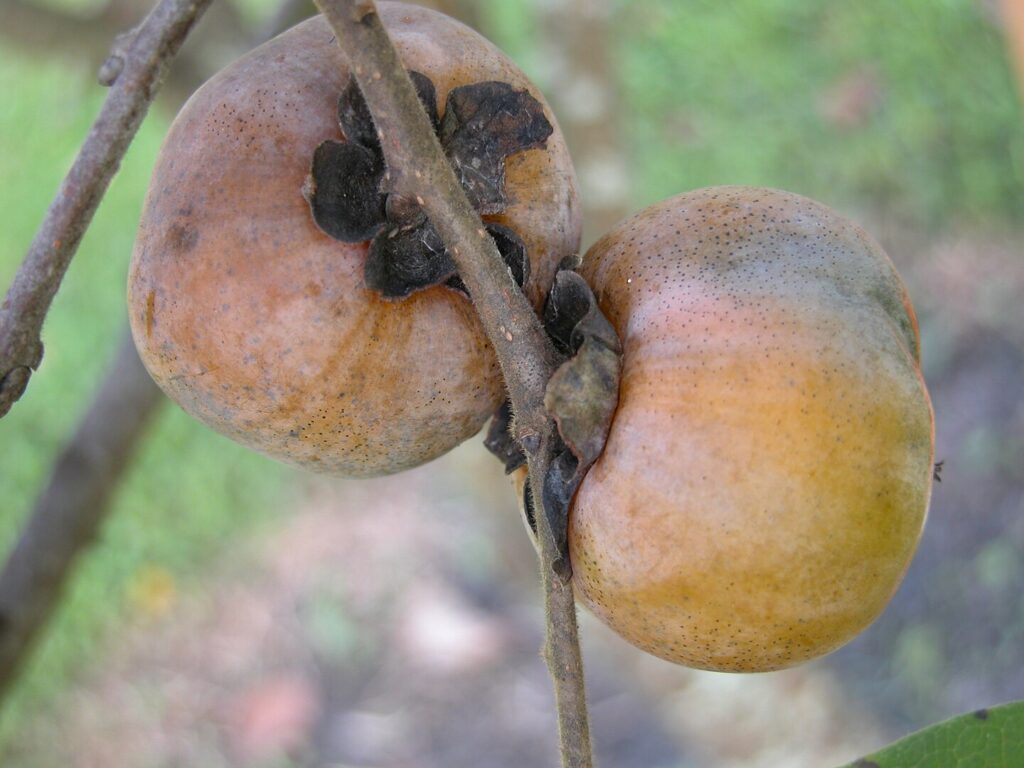
Native persimmon stands out among trees for Florida wildlife for its incredible fruit production and wildlife value. This medium-sized tree reaches 20-35 feet tall with an upright, somewhat pyramidal form. The glossy green leaves turn brilliant yellow-orange in fall, while the distinctive orange fruits persist on bare branches well into winter.
The large, sweet fruits support an amazing diversity of wildlife. Over 20 bird species feed on persimmons, including wild turkeys, woodpeckers, mockingbirds, and various thrushes. Mammals depend heavily on this reliable food source, with opossums, raccoons, foxes, and deer all feeding extensively on fallen fruit. The timing of fruit ripening—from late summer through winter—provides crucial sustenance during months when other food sources become scarce.
Persimmons are either male or female trees, so you’ll need both for fruit production, though many nurseries now sell grafted trees that include both sexes. The trees adapt to various soil types but prefer well-drained conditions and full sun to partial shade.
Dahoon Holly (Ilex cassine)
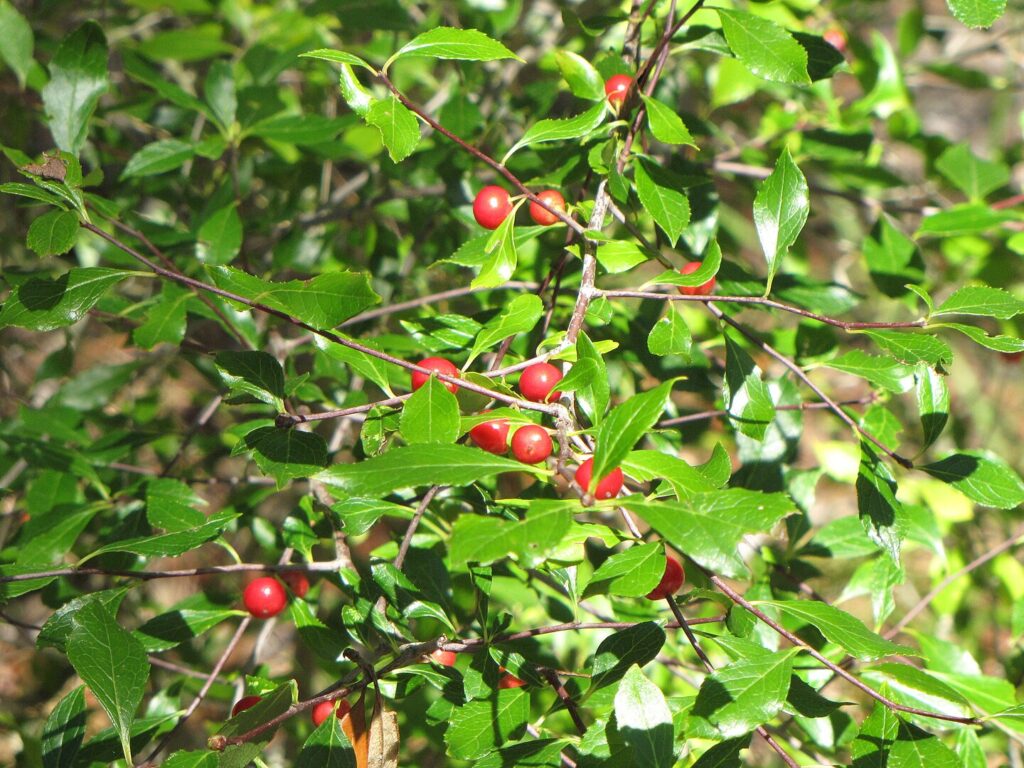
Dahoon holly provides year-round structure and winter wildlife food among trees for Florida wildlife. This attractive evergreen reaches 15-25 feet tall with a narrow, upright form perfect for smaller spaces. Small white flowers in spring are followed by brilliant red berries on female trees that persist through winter.
The berries are absolutely essential for winter bird survival, supporting cedar waxwings, robins, mockingbirds, thrashers, and numerous other species when most other food sources are unavailable. The evergreen structure provides critical winter shelter and nesting sites, while the dense branching offers protection from predators.
Like persimmons, hollies are either male or female, requiring both for berry production. The trees tolerate various moisture levels from dry to periodically wet, adapting well to Florida’s variable rainfall patterns. They prefer partial shade to full sun and require minimal maintenance once established.
These pine and sandhill trees for Florida wildlife excel in Florida’s sandy, well-drained soils while providing essential resources for species adapted to open, sunny environments. Their drought tolerance and low maintenance requirements make them excellent choices for sustainable wildlife landscaping.
Hardwood Hammock Small Trees
Hardwood hammocks represent Florida’s most diverse plant communities, featuring rich soils and partial shade conditions. These trees for Florida wildlife thrive in the dappled light beneath larger canopy trees, creating the understory layer that supports an incredible array of specialized species.
Wild Coffee (Psychotria nervosa)
Wild coffee ranks among the most valuable trees for Florida wildlife in shaded conditions. This small evergreen tree reaches 8-15 feet tall with glossy, dark green leaves and a naturally rounded form. Small clusters of white, tubular flowers bloom from spring through fall, followed by bright red berries that create stunning visual contrast against the dark foliage.
The plant serves as the exclusive host for white peacock butterfly larvae, making it essential for this beautiful native species. The continuous flowering provides nectar for various native bees, small butterflies, and beneficial insects throughout the growing season. The bright red berries attract over 25 bird species, including cardinals, mockingbirds, catbirds, and various warblers.
Wild coffee tolerates deep shade better than most flowering trees for Florida wildlife, making it perfect for areas under large canopy trees. It adapts to various soil types and requires minimal care once established, though it benefits from consistent moisture during dry periods.
Beautyberry (Callicarpa americana)
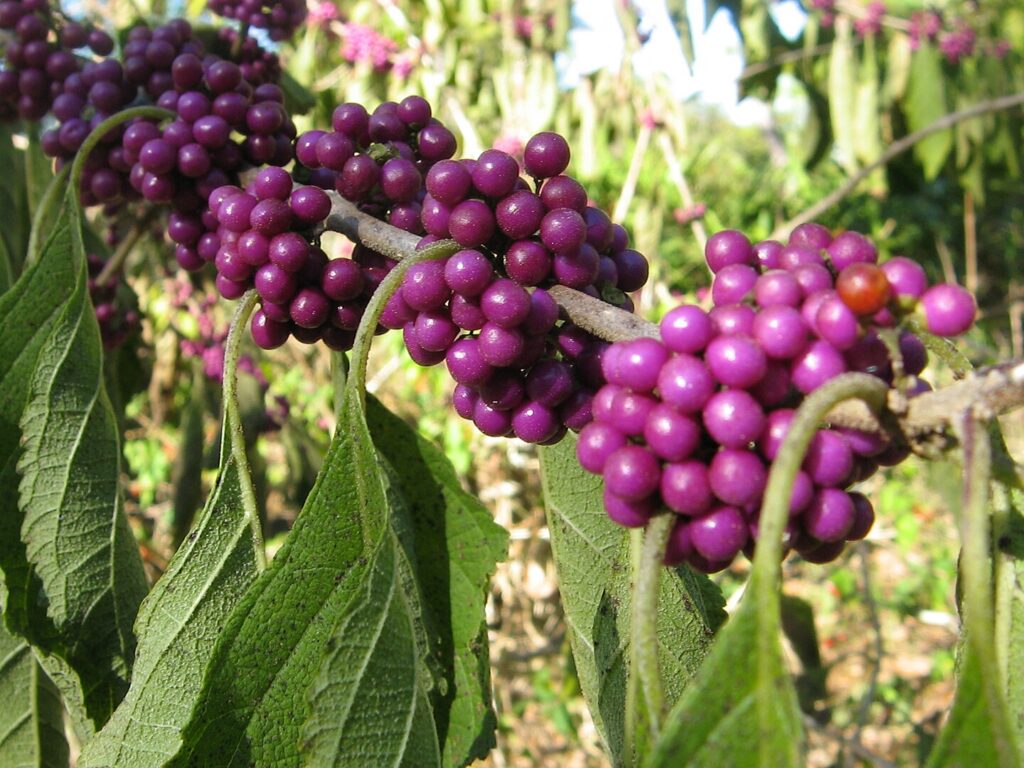
Beautyberry provides spectacular fall and winter wildlife value among trees for Florida wildlife. This deciduous small tree reaches 8-12 feet tall with an open, arching form. While the small pink flowers in summer are modest, the incredible clusters of bright purple berries that follow create one of nature’s most striking displays.
The berries support over 40 bird species, including mockingbirds, cardinals, thrashers, woodpeckers, and various songbirds. The fruit ripens in late summer and persists through fall, providing crucial nutrition during migration season. Small mammals, including foxes and raccoons, also feed heavily on the abundant fruit.
Beyond the berries, beautyberry leaves contain compounds that naturally repel mosquitoes and other biting insects—historically, people would crush the leaves and rub them on their skin. This natural pest control benefit extends to wildlife, creating more comfortable feeding and nesting areas.
Beautyberry adapts to various light conditions from full sun to partial shade, though it produces more berries with adequate sunlight. It tolerates different soil types and requires minimal maintenance, naturally forming an attractive, somewhat informal shape.
Paradise Tree/Bitterbrush (Picramnia pentandra)
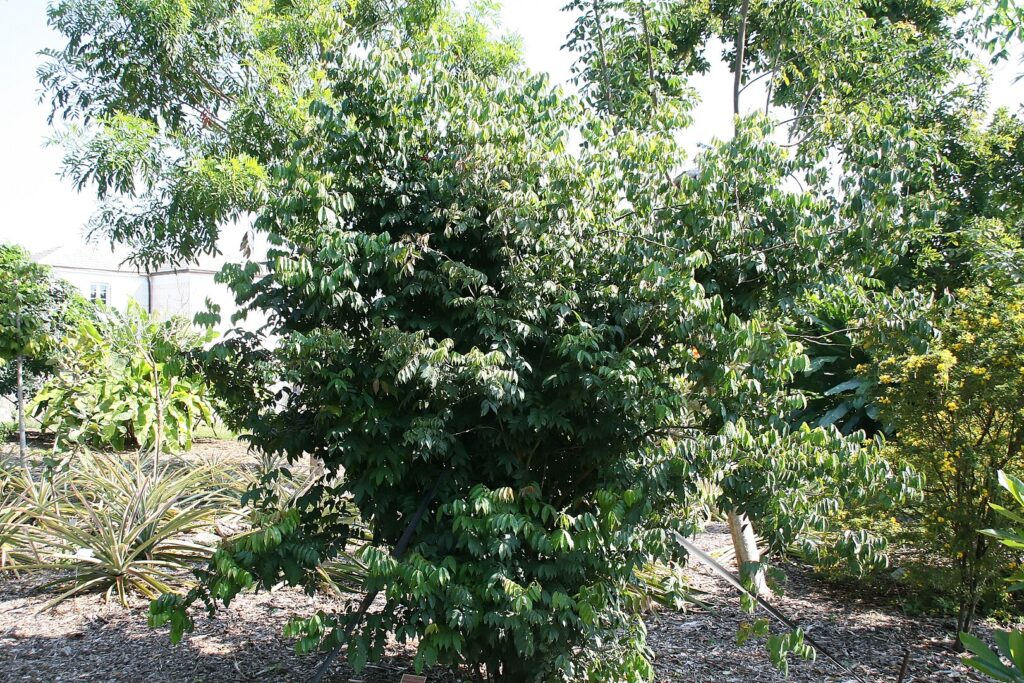
Paradise tree represents one of the most specialized trees for Florida wildlife, serving as the exclusive host plant for the endangered Schaus’ swallowtail butterfly. This small evergreen tree reaches 10-20 feet tall with distinctive compound leaves and an open branching structure.
Small greenish flowers bloom throughout the year, followed by small red berries that attract various songbirds. While the tree’s primary conservation value lies in supporting the rare Schaus’ swallowtail, it also provides nectar for other butterflies and native bees.
Paradise tree requires partial shade and well-drained soil, making it ideal for hammock understory conditions. It’s particularly valuable for South Florida properties where supporting endangered species becomes a conservation priority. The tree requires minimal care but benefits from protection from strong winds.
These hardwood hammock trees for Florida wildlife excel in shaded conditions while supporting some of Florida’s most specialized and rare species. Their ability to thrive beneath larger trees makes them essential for creating the layered habitat structure that maximizes wildlife diversity in your landscape.
Landscape Design with Wildlife Trees
Successfully incorporating trees for Florida wildlife into your landscape requires more than simply selecting native species—it demands understanding how these trees function as part of a larger ecosystem. Wildlife doesn’t recognize property lines, and the most successful wildlife gardens create seamless connections between your plantings and the natural world beyond your boundaries.
Creating Vertical Layers
The secret to transforming your property into a wildlife haven lies in mimicking nature’s vertical structure. In natural Florida ecosystems, vegetation occurs in distinct layers: the canopy layer formed by large trees, the understory of smaller trees, the shrub layer, and finally groundcovers and herbaceous plants. Each layer supports different wildlife species and provides different resources.
When planning your trees for Florida wildlife, think vertically. If you have space for a larger tree like a live oak or red maple, use it as your canopy anchor. Beneath this, plant understory trees like wild coffee or sweet bay magnolia. This layered approach creates microhabitats within your property—sunny edges for butterflies, shaded areas for forest birds, and transitional zones that support the greatest diversity of species.
Even small properties can achieve this effect. A single firebush trained as a small tree can serve as your “canopy” with beautyberry and native shrubs beneath, creating a scaled-down version of natural forest structure that still provides meaningful wildlife habitat.
Grouping by Ecosystem Type
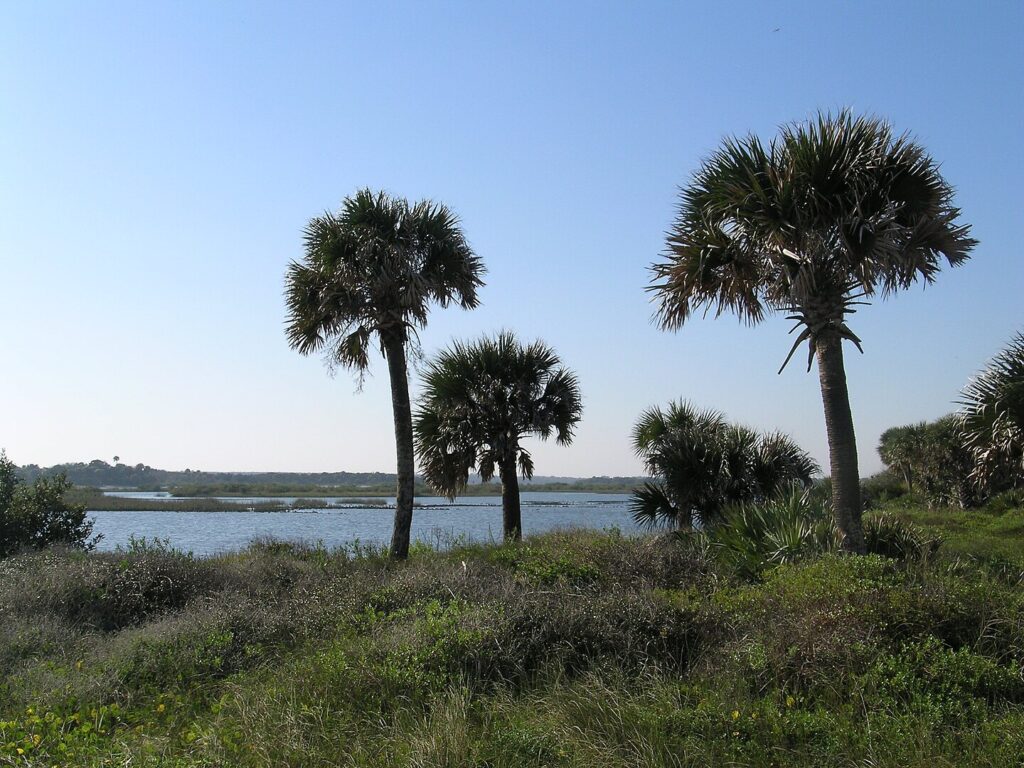
Rather than scattering different trees for Florida wildlife randomly throughout your landscape, group species according to their natural ecosystem associations. This approach not only looks more natural but also creates the specific habitat conditions that wildlife seeks.
Create a “coastal zone” using salt-tolerant species like firebush and marlberry, even if you’re miles from the beach. Establish a “wetland edge” around low-lying areas or near downspouts using buttonbush and red chokeberry. Develop a “sandhill area” in sunny, well-drained spots with Chickasaw plum and dahoon holly. This ecosystem-based approach helps wildlife navigate your property more intuitively while creating visually cohesive plant communities.
Consider your soil and water conditions when establishing these zones. Natural groupings work best when the trees’ cultural requirements match the site conditions, reducing maintenance while maximizing wildlife benefit.
Wildlife Corridor Connections
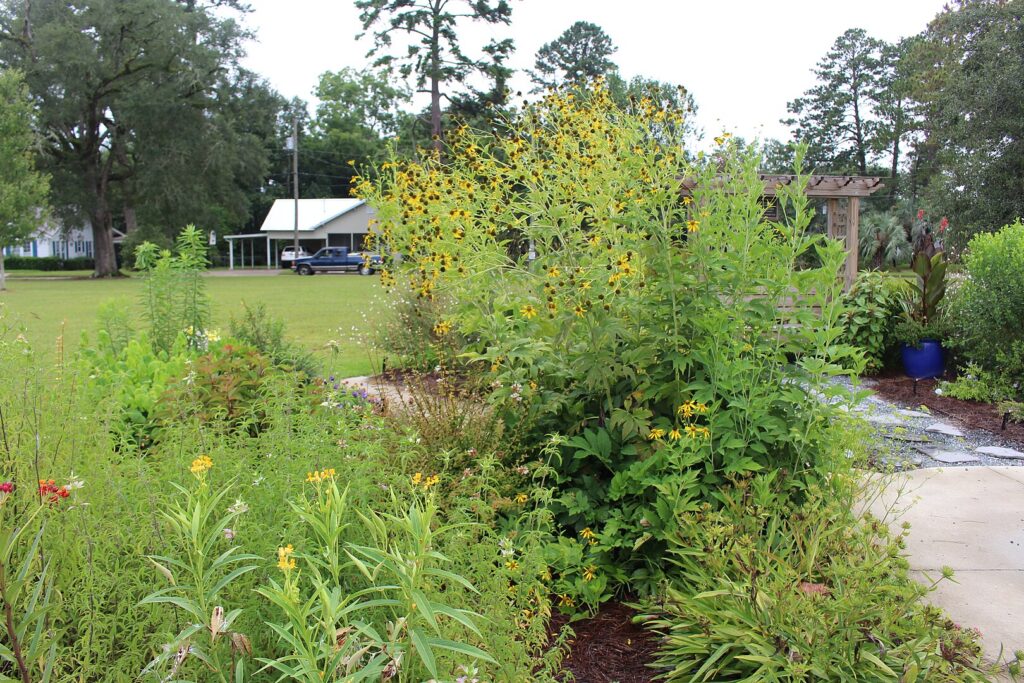
The most successful trees for Florida wildlife create connections—to neighboring properties, nearby natural areas, or even just from your front yard to your back yard. Wildlife moves along predictable corridors, and strategically placed trees can channel this movement through your property.
Survey your neighborhood for existing large native trees and natural areas, then plan your tree placement to create “stepping stones” of habitat. A line of coral bean trees can connect your property to a neighbor’s live oak, creating a flight path for hummingbirds and other species. Persimmon trees placed along property lines can extend natural corridors while providing boundary definition.
Don’t forget vertical corridors. Tall trees like dahoon holly can serve as “sky bridges” for birds moving between different habitat areas, while lower-growing species create ground-level pathways for small mammals and terrestrial creatures.
Seasonal Succession Planning
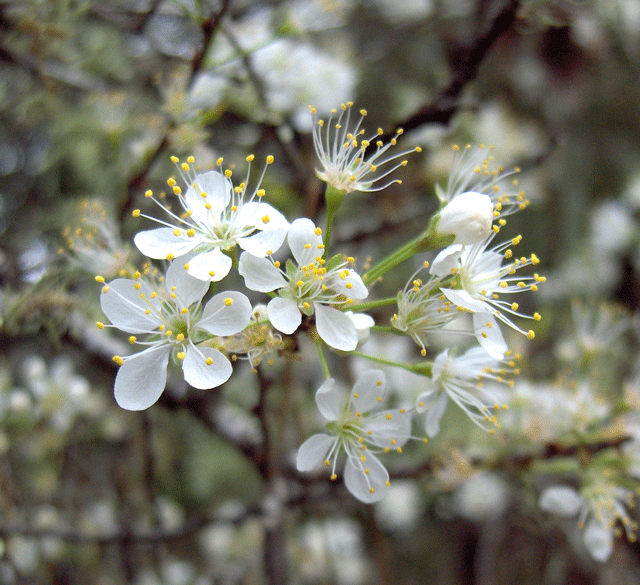
The best wildlife landscapes provide resources throughout the year, and planning seasonal succession among your trees for Florida wildlife ensures continuous habitat value. Early bloomers like Chickasaw plum support emerging pollinators in late winter. Spring-flowering species like sweet bay magnolia bridge the gap to summer bloomers like firebush, which continues flowering until fall.
Fall fruit production becomes critical for migration season—marlberry, beautyberry, and persimmon all provide essential fuel for birds preparing for long journeys or building fat reserves for winter. Winter structure matters too; evergreen species like wild coffee and dahoon holly provide shelter during cold snaps, while persistent fruit on deciduous trees sustains resident wildlife through lean months.
Plan your tree placement to create a rhythm of bloom and fruit throughout the seasons. This approach ensures your property remains an active wildlife destination year-round rather than just during peak growing season.
By thoughtfully designing with these principles, your trees for Florida wildlife become more than individual plants—they transform into a functioning ecosystem that supports the full spectrum of native species while creating a beautiful, dynamic landscape that changes with the seasons and grows more valuable to wildlife over time.
Planting Guide for Wildlife Trees
Successfully establishing trees for Florida wildlife requires understanding Florida’s unique climate patterns and soil conditions. Unlike many regions with predictable spring planting seasons, Florida’s year-round growing season and distinct wet and dry periods create specific opportunities and challenges for tree establishment.
Site Preparation
Before planting any trees for Florida wildlife, conduct a thorough site assessment. Florida’s diverse soils range from deep sands to heavy clays, often within the same property. Test your soil’s pH, drainage, and organic matter content to match trees to appropriate locations.
Most native Florida trees prefer slightly acidic to neutral soils (pH 6.0-7.0), but coastal species like firebush tolerate more alkaline conditions common in shell-based soils. Drainage proves critical—wetland-edge species like buttonbush thrive in poorly drained areas, while sandhill species like Chickasaw plum require excellent drainage to prevent root rot.
Improve soil gradually rather than dramatically. Native trees for Florida wildlife have adapted to local soil conditions, and over-amending can actually harm establishment. For sandy soils, incorporate modest amounts of compost to improve water retention. For clay soils, create raised planting areas or choose species like red maple that tolerate heavier soils.
Remove invasive plants from the planting area, including aggressive grasses like cogon grass or Brazilian pepper seedlings. These competitors can overwhelm young native trees, preventing successful establishment.
Planting Timeline
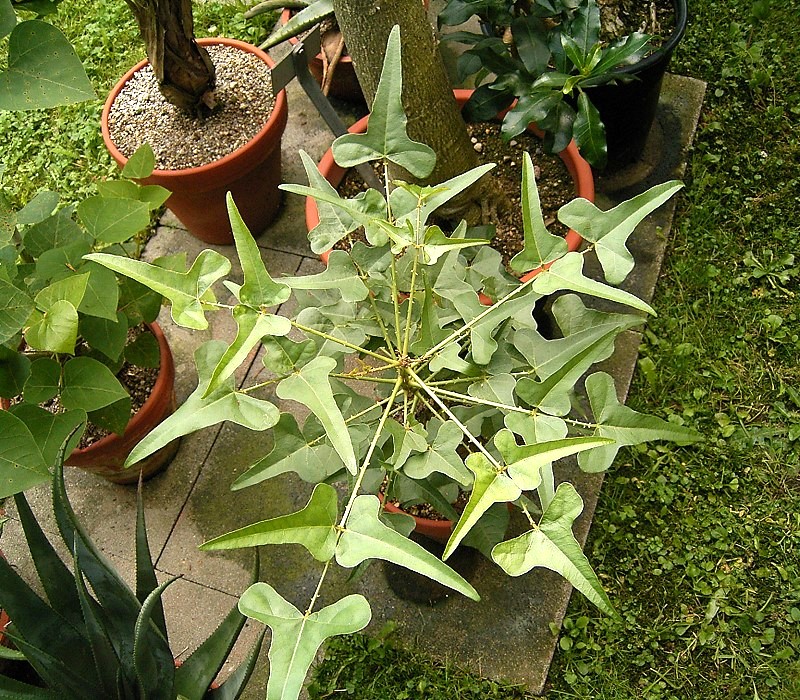
Florida’s planting calendar differs significantly from temperate regions. The optimal planting window for trees for Florida wildlife runs from October through February, taking advantage of cooler temperatures and naturally increasing rainfall patterns.
October through December represents the ideal planting period. Temperatures moderate, humidity decreases, and winter rains begin, providing natural irrigation while trees establish root systems. Trees planted during this window have months to develop strong roots before facing summer heat and potential drought.
January and February extend the planting window, though trees planted later in this period may require more irrigation during establishment. March plantings can succeed but require careful attention to watering as temperatures rise and rainfall becomes less predictable.
Avoid planting trees for Florida wildlife from April through September unless you can provide consistent irrigation. Summer heat, humidity, and irregular rainfall patterns stress newly planted trees, while hurricane season poses additional risks to shallow-rooted specimens.
Spacing and Placement
Proper spacing ensures your trees for Florida wildlife reach their full potential while avoiding overcrowding as they mature. Research each species’ mature size and plan accordingly—many gardeners underestimate how quickly Florida’s native trees grow in favorable conditions.
Small trees like wild coffee and beautyberry need 8-12 feet spacing from other trees, while medium-sized species like sweet bay magnolia require 15-20 feet. Consider not just mature canopy spread but also root system development, which often extends well beyond the canopy.
Position trees for Florida wildlife to maximize their specific benefits. Place early-blooming species like Chickasaw plum where they’re visible from windows, allowing you to observe the incredible pollinator activity. Site fragrant trees like sweet bay magnolia near patios or walkways where their perfume can be appreciated.
Consider mature height in relation to structures, power lines, and views. While most trees in this guide remain relatively small, species like dahoon holly can reach 25 feet, potentially affecting sight lines or requiring future pruning if poorly placed.
Establishment Care
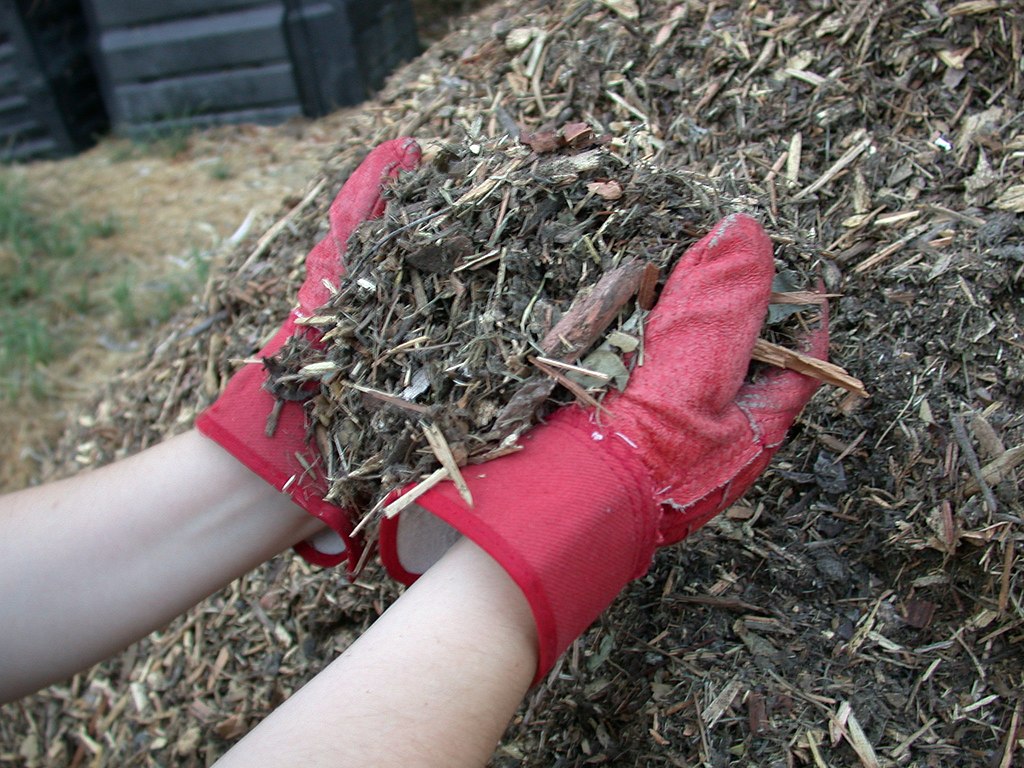
The first two years prove critical for trees for Florida wildlife. During this establishment period, consistent watering trumps all other care practices. Water deeply but infrequently, encouraging deep root development rather than shallow surface roots.
For the first month, water every 2-3 days, providing enough water to saturate the root ball and surrounding soil. Gradually reduce frequency over the first year, transitioning to weekly watering during dry periods. By the second year, most native trees require supplemental water only during extended droughts.
Mulch proves essential for tree establishment, but use native materials when possible. Pine needles, oak leaves, or melaleuca mulch (from removed invasive trees) provide excellent options. Avoid cypress mulch, which often comes from environmentally sensitive areas, and never use dyed mulches that can harm soil organisms.
Apply mulch 3-4 inches deep in a wide circle around the tree, keeping mulch several inches away from the trunk to prevent pest issues. This mulch layer conserves moisture, moderates soil temperature, and gradually decomposes to improve soil organic matter.
Fertilization should be minimal or avoided entirely for trees for Florida wildlife. Native trees have adapted to Florida’s naturally nutrient-poor soils, and excess fertilization can promote rapid, weak growth susceptible to storm damage. If growth seems slow, address underlying soil drainage or pH issues rather than adding fertilizer.
Staking is rarely necessary for trees under 6 feet tall unless your site experiences extreme winds. When staking is required, use flexible ties that allow some movement, promoting stronger trunk development. Remove stakes after one growing season to prevent girdling injuries.
By following these guidelines, your trees for Florida wildlife will establish strong root systems and healthy growth patterns, setting the foundation for decades of wildlife habitat and natural beauty in your landscape.
Maintenance for Maximum Wildlife Benefit
Maintaining trees for Florida wildlife requires a fundamental shift in perspective from traditional landscaping approaches. Instead of pursuing the manicured perfection often associated with ornamental trees, wildlife-focused maintenance emphasizes natural processes and accepts that some “imperfections” actually benefit the creatures you’re trying to attract.
Pruning Timing
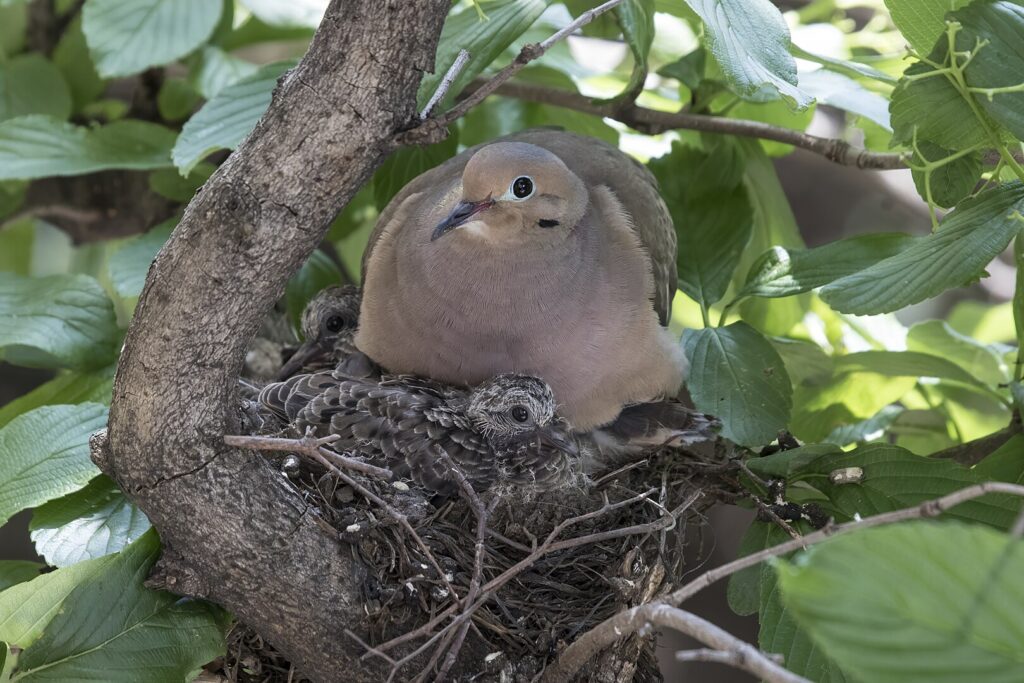
Timing pruning activities around wildlife needs represents one of the most important maintenance considerations for trees for Florida wildlife. Florida’s year-round growing season means birds may nest at unexpected times, making careful observation essential before picking up pruning tools.
The optimal pruning window runs from late fall through early winter (November through January), when most birds have finished nesting and before spring breeding activities begin. This timing also coincides with trees’ natural dormancy period, minimizing stress and promoting healthy regrowth.
Avoid pruning trees from February through August, which encompasses the primary nesting season for most Florida birds. Even minor pruning activities can disturb nesting birds or destroy active nests, potentially violating federal wildlife protection laws. If emergency pruning becomes necessary during nesting season, carefully inspect trees for active nests before beginning work.
When pruning, maintain each tree’s natural form rather than imposing artificial shapes. Wildlife has evolved to use trees in their natural configurations, and dramatic shaping can eliminate crucial nesting sites, perching spots, or feeding opportunities. Remove only dead, damaged, or crossing branches, allowing trees to develop their characteristic wildlife-friendly structure.
For fruiting trees for Florida wildlife like beautyberry or marlberry, avoid heavy pruning that removes flower buds and reduces fruit production. Light annual pruning to remove dead wood and maintain shape provides better wildlife value than infrequent heavy pruning.
Pest Management
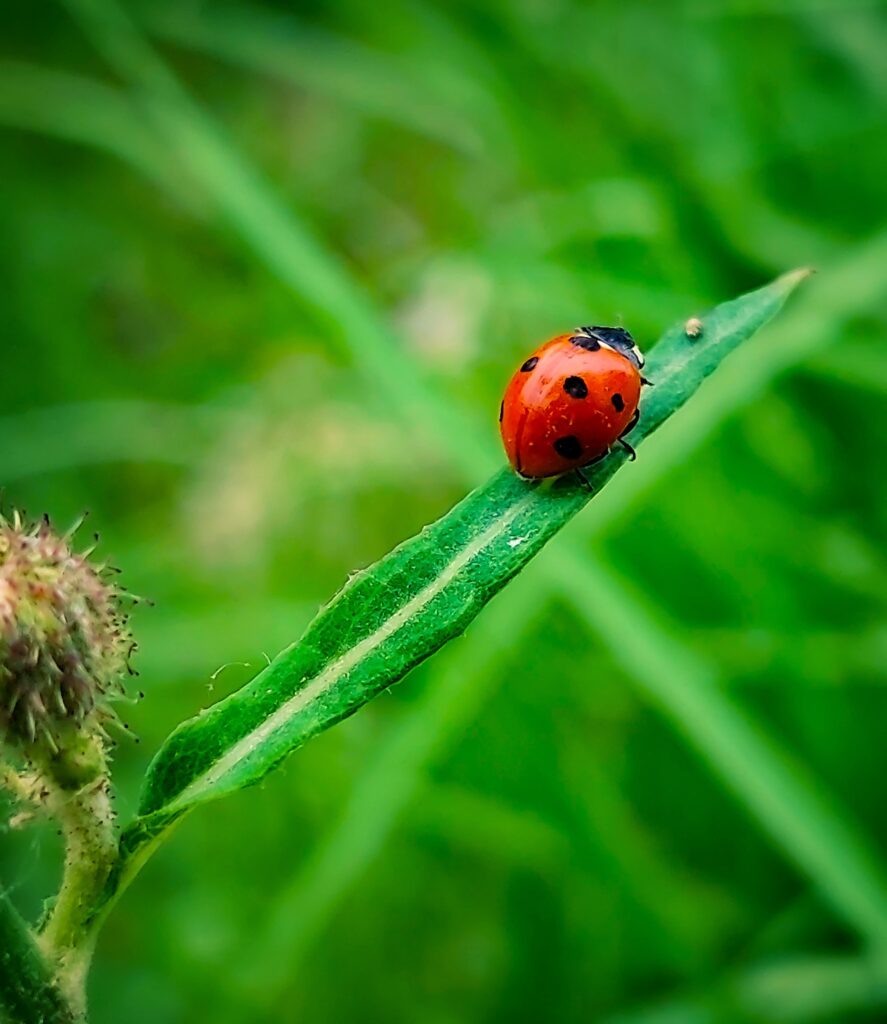
Managing pests on trees for Florida wildlife requires accepting that some insect damage actually benefits the ecosystem you’re creating. Many insects that feed on native trees serve as essential food sources for birds, particularly during breeding season when protein-rich insects are crucial for raising young.
Caterpillars feeding on live oak leaves, for example, represent food for dozens of bird species rather than a problem requiring intervention. Similarly, aphids on red maple provide sustenance for beneficial insects like ladybugs and lacewings, which in turn feed birds and help control other garden pests.
Focus pest management efforts only on introduced pests that can seriously damage or kill trees. Scale insects, particularly on stressed trees, may require treatment with horticultural oil applications. Apply treatments during cooler months when beneficial insects are less active, and choose targeted approaches that minimize impact on non-target species.
Avoid broad-spectrum pesticides entirely on trees for Florida wildlife. These chemicals persist in the environment, accumulating in insects that birds consume and potentially causing serious harm to the wildlife you’re trying to support. Even “organic” pesticides like neem can harm beneficial insects when applied during active periods.
Instead, promote natural pest control by maintaining diverse plantings that support beneficial insects and birds. Healthy trees for Florida wildlife in properly designed landscapes rarely experience pest problems severe enough to require intervention.
Seed and Fruit Management
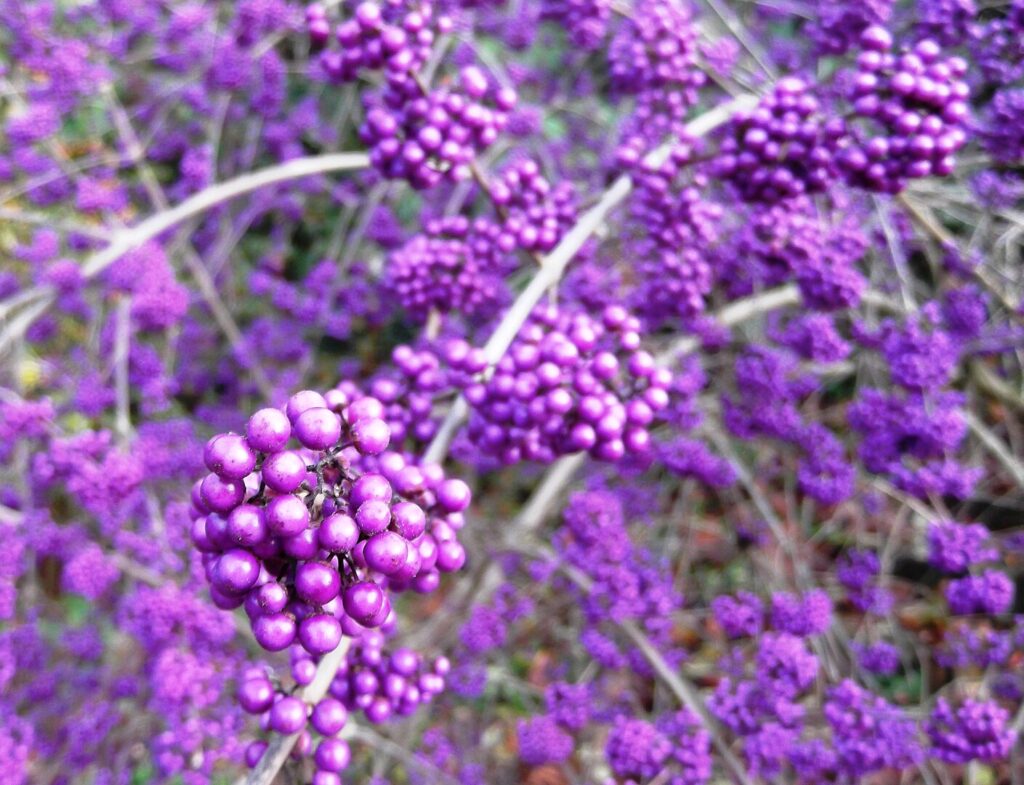
Managing seed and fruit production requires balancing wildlife needs with landscape aesthetics and practical concerns. The messy fruit drop that many homeowners view as problematic actually represents peak wildlife feeding opportunities.
Allow fruits to ripen naturally on trees for Florida wildlife, resisting the urge to clean up fallen fruit immediately. Ground-feeding birds like thrushes and towhees depend on this fallen fruit, while decomposing fruit supports beneficial insects that feed other wildlife. Wait until fruit has been thoroughly consumed or has decomposed before cleaning up remaining debris.
For trees producing large amounts of fruit near walkways or patios, consider strategic placement of ground covers that can handle fruit drop, such as native ferns or sedges. These plants will benefit from the natural mulch while minimizing maintenance concerns.
Seed heads on trees like buttonbush should remain intact through winter, providing food for finches and other seed-eating birds. Only remove old seed heads in late winter before new growth begins, and compost this material to return nutrients to your landscape.
Some trees for Florida wildlife, like persimmons, produce such abundant fruit that thinning may be necessary to prevent branch breakage. When thinning is required, do so early in the fruit development process, leaving remaining fruits to mature fully for maximum wildlife benefit.
By adapting your maintenance approach to prioritize wildlife needs, your trees for Florida wildlife will provide maximum ecological benefit while requiring less intensive care than traditional landscape trees. This wildlife-focused maintenance philosophy creates healthier, more resilient trees that serve as productive habitat for generations of Florida’s native species.
Growing a Wildlife Legacy
Native Florida trees represent one of the most impactful investments in wildlife conservation that property owners can make. By choosing species that have evolved alongside local fauna over millennia, we create ecosystems that support the intricate web of relationships between plants, insects, birds, mammals, and countless other organisms that call Florida home.
The journey from planting a single native tree to establishing a thriving wildlife habitat requires patience, planning, and ongoing commitment. However, the rewards—watching migrating warblers fuel up on native fruit, observing butterflies complete their life cycles on indigenous host plants, or hearing the return of native bird species to your property—make every effort worthwhile. As Florida continues to face unprecedented development pressure and environmental challenges, these individual actions collectively contribute to a larger conservation legacy that will benefit wildlife for generations to come.
